The rhythm action genre once dominated living rooms worldwide, and as a dedicated content creator for guitarplayers.net and a long-time aficionado of plastic instruments, the resurgence of both Guitar Hero and Rock Band in 2015 was a momentous occasion. For enthusiasts like myself, the arrival of Guitar Hero Live and Rock Band 4 presented a thrilling dilemma: which game would reign supreme on the PS4?
While the casual gaming audience might only opt for one title, the nuances between Guitar Hero Live and Rock Band 4 are significant, especially for those passionate about virtual guitar shredding on their PlayStation 4. Having invested considerable time and personal funds into both games upon their release for the PS4, I’m equipped to provide an objective and comprehensive comparison to guide your decision. Let’s dive in and see which game strikes the right chord for you on the PlayStation 4.
Round 1: Backwards Compatibility on PS4
For many seasoned rhythm game players, the question of utilizing existing peripherals is crucial. Do those dusty plastic guitars from previous generations still have a purpose? A game that embraces backwards compatibility on the PS4 is undoubtedly a plus.
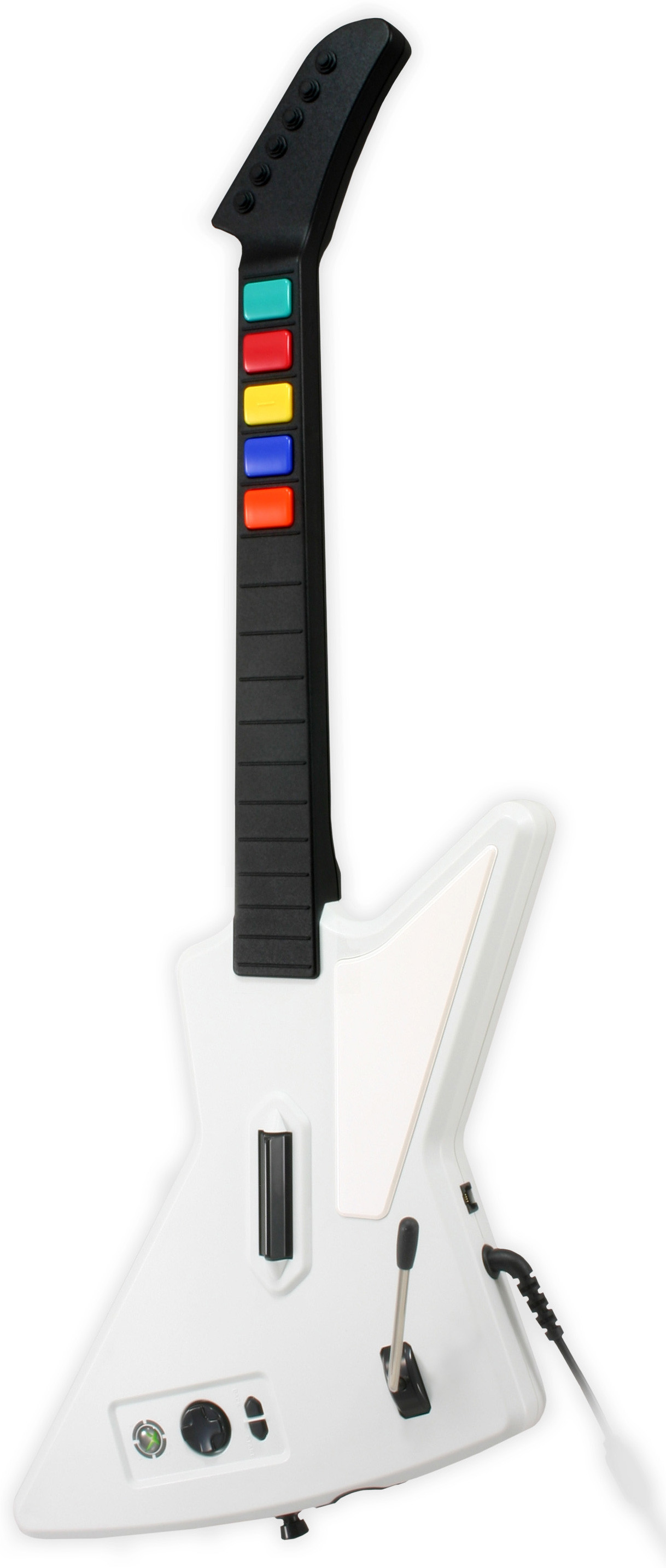 Sleep well, sweet prince of plastic video game instruments
Sleep well, sweet prince of plastic video game instruments
Image alt text: A nostalgic view of a retired Guitar Hero 2 controller, symbolizing the end of an era for some peripherals.
Rock Band 4 on PS4 champions backwards compatibility, largely delivering on its promise to support legacy Rock Band and Guitar Hero instruments. My wireless Guitar Hero 3 guitar designed for the Xbox 360 seamlessly paired with the PS4 version of Rock Band 4.
However, compatibility isn’t flawless. Due to console security protocols, wired controllers are not supported. Sadly, this meant my cherished Guitar Hero II Xplorer, my go-to guitar for countless hours across Guitar Hero and Rock Band on Xbox 360, had to be retired from PS4 sessions.
Despite this specific limitation, most wireless, last-generation controllers should function smoothly with Rock Band 4 on PS4.
Guitar Hero Live for PS4 adopts a different stance. Its revolutionary new button configuration (detailed in the next section) renders the classic five-button system obsolete. Consequently, none of your prior controllers are compatible with Guitar Hero Live on the PS4.
Winner – Rock Band 4
Round 2: Guitar Gameplay Revolution vs. Evolution on PS4
While Rock Band expanded the rhythm game experience with drums, vocals, and keyboards, guitar remains the core instrument for many enthusiasts.
Rock Band 4 on PS4 adheres to the familiar five-color lane system. If you’re accustomed to previous Rock Band or Guitar Hero titles, you’ll feel instantly comfortable.
The primary gameplay innovation is the inclusion of Freestyle Guitar Solos. These sections empower players to improvise, and the game intelligently interprets your notes to create a coherent solo.
 Rock Band 4
Rock Band 4
Image alt text: A screenshot from Rock Band 4 displaying the freestyle guitar solo mode with yellow note lanes on the PS4.
These freestyle solos seem inspired by Harmonix’s Fantasia: Music Evolved. Personally, they feel somewhat extraneous, often producing somewhat disjointed solos. Thankfully, there’s an option to disable them.
In contrast to Rock Band 4‘s evolutionary approach, Guitar Hero Live on PS4 embodies revolution. It abandons the five-color buttons for a novel guitar controller featuring two rows of three buttons.
This new setup creates a more authentic guitar-playing sensation. On higher difficulties, you’ll grapple with complex chords spanning both button rows. Mastering these chords through muscle memory offers a profoundly rewarding experience.
This bold redesign was a calculated risk, but Freestyle Games, renowned for the innovative DJ Hero controllers, had a proven track record of hardware excellence.
After an initial adjustment period, the Guitar Hero Live control system enhances the guitar gameplay experience beyond the widely accepted five-button standard. For sheer guitar playing feel, Guitar Hero Live takes the lead on PS4.
Winner – Guitar Hero Live
Round 3: Beyond Guitar: Instrument Variety on PS4
This round is decidedly lopsided, with only one contender truly participating. The game titles themselves hint at the distinction.
Rock Band 4 on PS4 remains centered on band dynamics. Drums, bass guitar, and vocals are integral components, and again, most wireless legacy controllers (excluding wired ones) are compatible.
Regrettably, Rock Band 3 keyboard controllers are not supported; Rock Band 4 eliminated keyboard functionality, prematurely ending the potential of a promising instrument within the series.
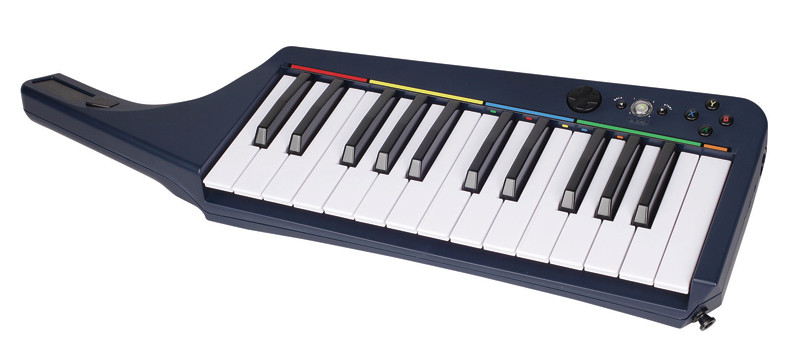 I suppose you can sleep well too, though I
I suppose you can sleep well too, though I
Image alt text: A Rock Band 3 keyboard instrument, rendered obsolete in Rock Band 4, highlighting the shift in instrument focus on PS4.
Guitar Hero Live, focusing on the core guitar experience, forgoes other instruments entirely on PS4. It prioritizes the lead guitarist role, excluding drums and even bass guitar as playable instruments.
Vocal support is present, via a Logitech-compatible microphone or the Guitar Hero Live companion app for iOS. However, the primary focus is undeniably mastering the guitar, leaving other instruments behind.
Winner – Rock Band 4
Round 4: Visual Style and Immersion on PS4
Visual preference is subjective, so bear with me if your opinion differs.
Rock Band 4 on PS4 maintains a visual continuity with previous installments, offering expected graphical enhancements, although not dramatically noticeable.
The aesthetic remains distinctly Rock Band, with the familiar band creation process and stylized polygonal characters. This engine is designed to accommodate a vast library of downloadable songs, ensuring seamless integration of DLC with character animations and lip-syncing.
 Let
Let
Image alt text: A typical band performance scene in Rock Band 4, showcasing the familiar visual style retained on the PS4.
Guitar Hero Live on PS4 adopts a radically different visual approach, centered around full-motion video, a choice that yields mixed results across its two main modes.
The GHTV mode, a streaming music channel concept, benefits from this approach. Each song is accompanied by its official music video, offering a compelling way to discover new artists and songs. Music discovery is a core appeal of this genre.
The GH Live mode presents live concert simulations from a first-person perspective, with dynamic crowd reactions based on your performance.
While conceptually innovative, the execution feels less revolutionary. It essentially alternates between “good” and “bad” performance videos with somewhat jarring transitions.
Furthermore, the GH Live mode’s hyper-realistic, flawlessly attractive band members and crowds can feel jarring and unrealistic. It detracts from the rock band fantasy, instead evoking a manufactured, overly polished vibe.
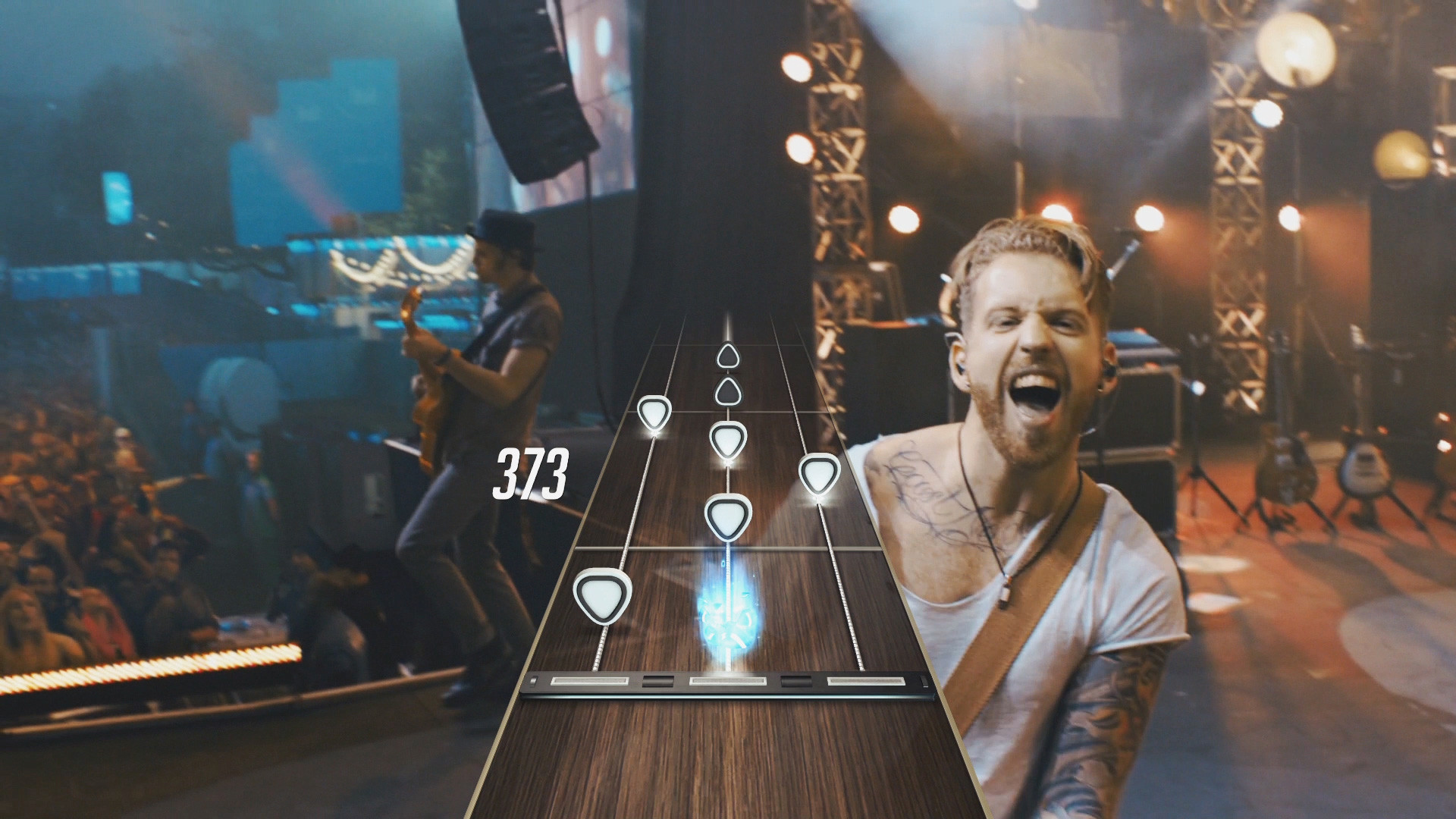 Get off my fucking telly, you complete and utter immaculate moron
Get off my fucking telly, you complete and utter immaculate moron
Image alt text: A scene from Guitar Hero Live’s first-person concert mode, highlighting the hyper-realistic and potentially off-putting character visuals on PS4.
While the GH Live mode’s aesthetic is divisive, the GHTV mode’s music video integration gives Guitar Hero Live a visual edge over its more visually consistent competitor on PS4.
Winner – Guitar Hero Live
Round 5: On-Disc and Free Content on PS4
For players averse to downloadable content, the initial content offering is paramount. How much playable content is available out-of-the-box, without further expenditure?
Rock Band 4 provides 65 on-disc songs, spanning from classic tracks of the 1960s to contemporary hits.
Expanding this library necessitates purchasing DLC, with minimal free content available online. Even importing tracks from Rock Band 3 incurs a cost.
Guitar Hero Live’s concert mode features 42 songs, ranging from 1960s classics to more recent tracks.
However, the GHTV mode launched with 200 streaming music videos, playable at no additional cost. Since launch, over 90 more songs have been added, ensuring a continuous influx of free content.
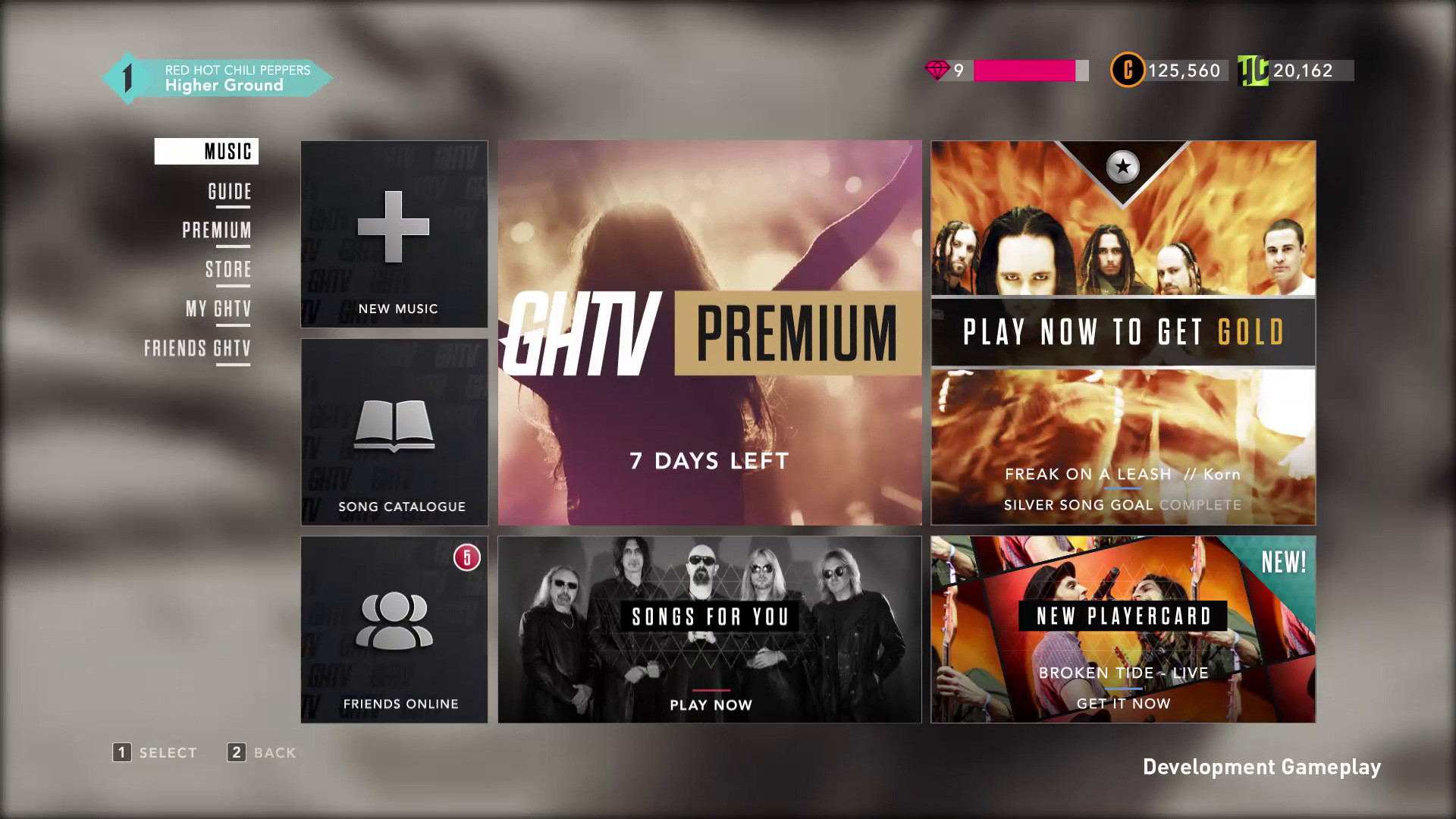 The GHTV mode in all its glory. This is Guitar Hero Live
The GHTV mode in all its glory. This is Guitar Hero Live
Image alt text: A vibrant screenshot of Guitar Hero TV (GHTV) mode, showcasing the streaming music video interface and free content access on Guitar Hero Live for PS4.
While GHTV’s streaming nature means song selection isn’t entirely on-demand, play tokens, earned through gameplay or purchased with real currency, grant on-demand access.
With its ever-expanding library of free, streaming content, Guitar Hero Live delivers more initial content value than Rock Band 4 on PS4.
Winner – Guitar Hero Live
Round 6: Downloadable Content and Song Libraries on PS4
For players willing to invest in downloadable content to expand their music libraries, the DLC landscape is crucial.
Guitar Hero Live becomes less appealing in this context. While GHTV offers a vast library, song ownership is illusory. On-demand play requires tokens, necessitating continuous expenditure to repeatedly play specific songs.
Obsessive replay of a favorite song like Queen’s “Fat Bottomed Girls” becomes costly, requiring token purchases.
Furthermore, the full-motion video GH Live mode, with bespoke videos and actors, makes DLC expansion economically prohibitive. Don’t expect future paid DLC additions to the initial 42 songs.
Rock Band 4 presents a stark contrast. Its engine is designed for seamless DLC integration, and it has done so extensively.
A vast majority of Rock Band 3 DLC has been ported to Rock Band 4, resulting in a library exceeding 1500 songs for purchase.
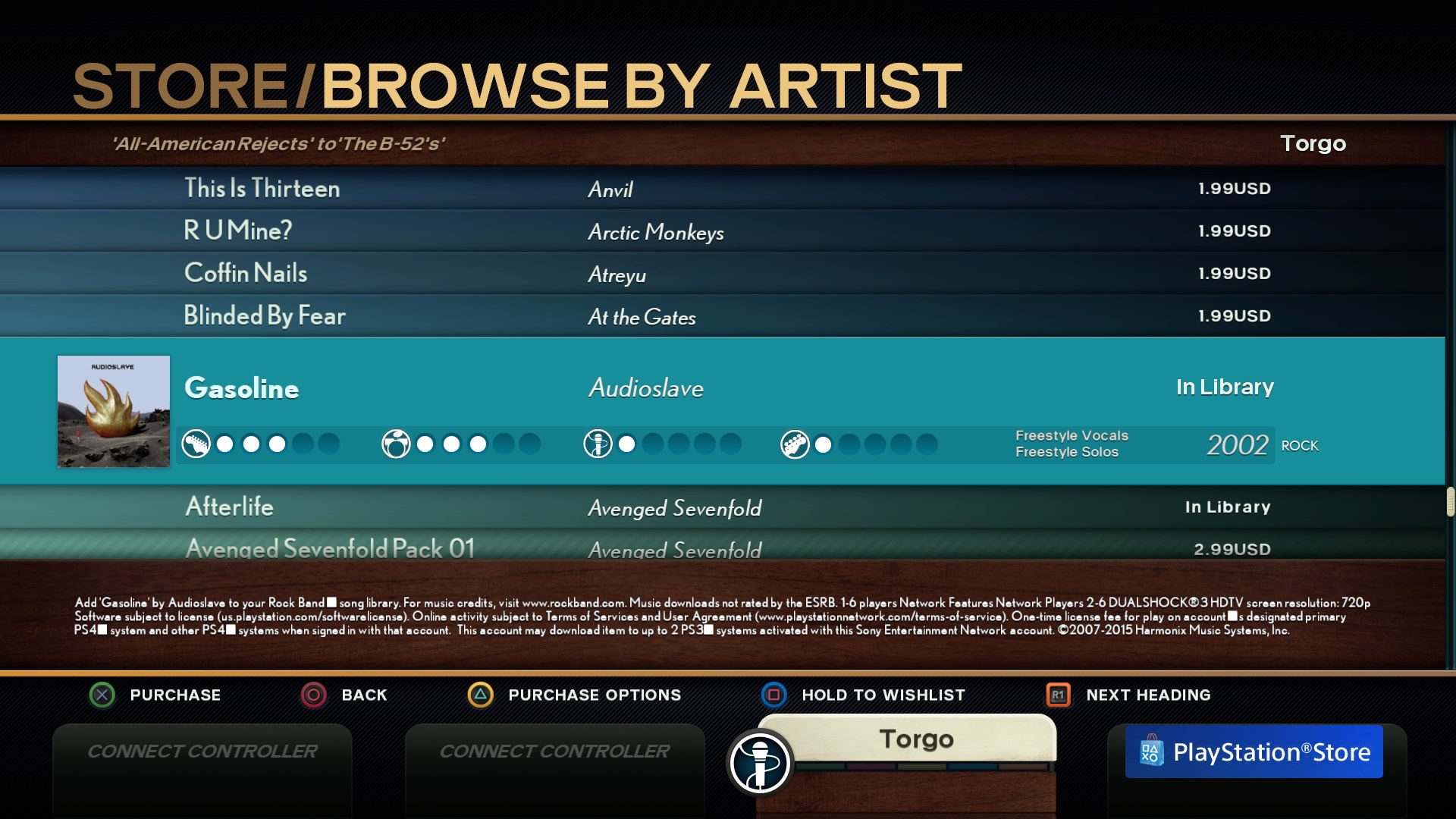 You can even buy Audioslave stuff if you want to pretend it
You can even buy Audioslave stuff if you want to pretend it
Image alt text: Rock Band 4’s extensive DLC library includes artists like Audioslave, illustrating the depth of downloadable content available on PS4.
Crucially, purchased Rock Band 4 DLC is owned outright, playable indefinitely.
For players prepared to regularly invest in expanding their song library, Rock Band 4 is the superior choice on PS4.
Winner – Rock Band 4
Round 7: Single-Player Experience on PS4
Rhythm games offer distinct experiences for solo and multiplayer sessions. How do these titles cater to the solitary guitarist on PS4?
With its lead guitar focus, first-person perspective, and instrument streamlining, Guitar Hero Live is clearly designed with single-player engagement in mind.
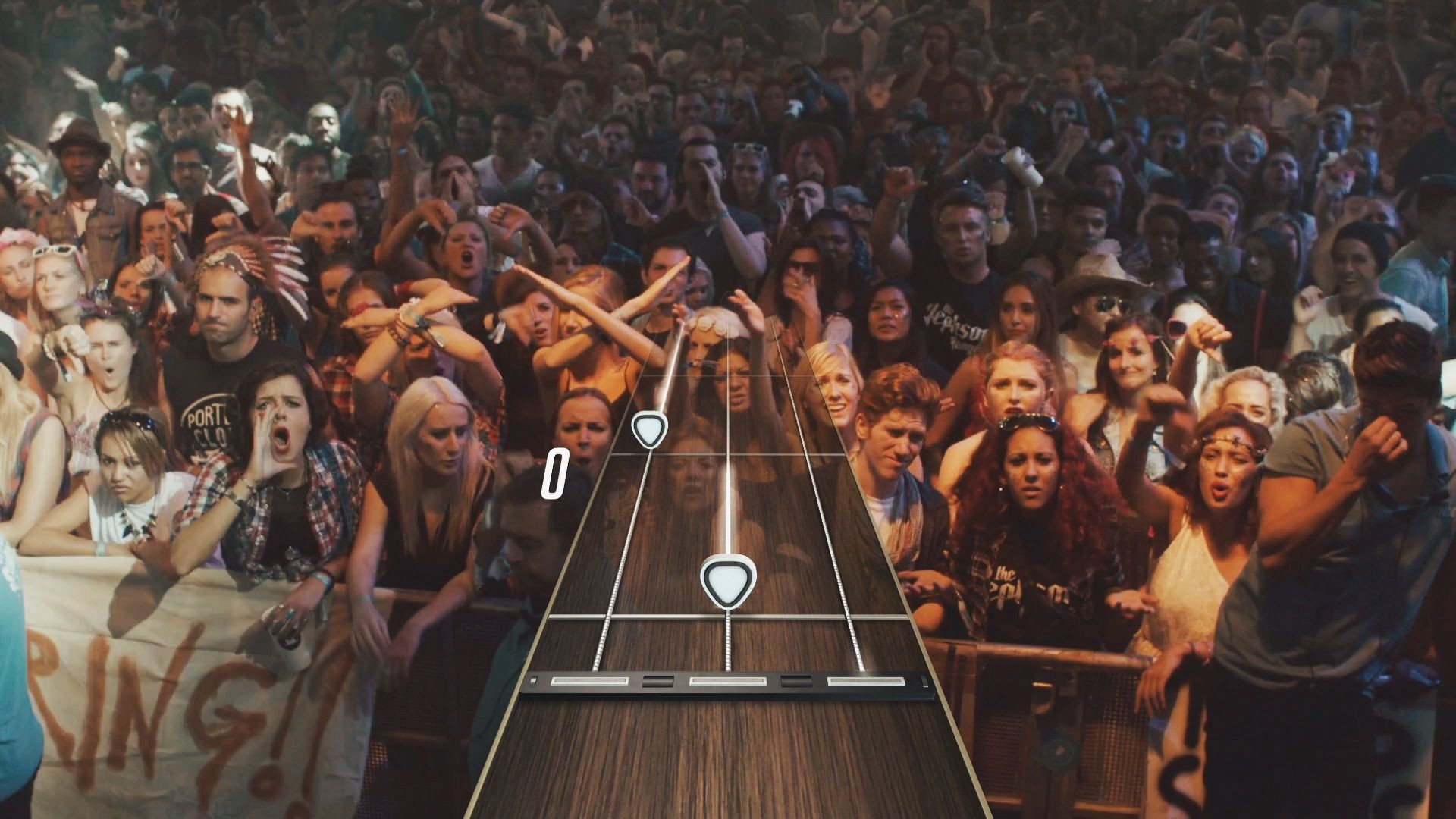 You
You
Image alt text: A first-person perspective view from Guitar Hero Live, emphasizing the single-player focused immersion on the PS4.
The GHTV mode features profile creation and experience progression. Playing songs and earning experience unlocks cosmetic items like highway styles and profile icons.
Each GHTV song includes specific challenges (star ratings, etc.), enhancing replayability for solo players.
Rock Band 4 offers less compelling single-player progression. Its Career mode is surprisingly brief compared to Rock Band 3. Beyond Career mode, solo play is limited to Quick Play song selection.
For a single-player experience with a sense of progression and reward, Guitar Hero Live is the more compelling option on PS4.
Winner – Guitar Hero Live
Round 8: Local Multiplayer Mayhem on PS4
The plastic instrument genre truly shines in local multiplayer, bringing friends and family together for musical mayhem.
In this realm, Guitar Hero Live falters significantly on PS4. Local multiplayer is rudimentary, limited to two guitars in GHTV mode, both playing the same instrument part.
This fosters competition rather than cooperation, and mismatched skill levels can make for an unbalanced and less enjoyable experience.
 Not even Weezer can make local multiplayer better in Guitar Hero Live
Not even Weezer can make local multiplayer better in Guitar Hero Live
Image alt text: A band featuring Weezer in Guitar Hero Live, ironically highlighting the game’s weaker local multiplayer focus on PS4.
As previously noted, Guitar Hero Live prioritizes single-player. Rock Band 4, however, embraces multiplayer wholeheartedly on PS4.
While not revolutionary, Rock Band 4 retains the magic of four-player local band sessions, with lead guitar, bass, drums, and vocals harmonizing for multiplier-fueled musical synergy.
Rock Band‘s multiplayer was a genre benchmark, and Rock Band 4 wisely preserves this successful formula.
For regular local multiplayer sessions, Rock Band 4 is unequivocally the superior choice on PS4.
Winner – Rock Band 4
Round 9: Ongoing Support and Updates on PS4
Both Harmonix and Activision have indicated that Rock Band 4 and Guitar Hero Live are intended as ongoing platforms, receiving continuous updates rather than sequels.
Within two months of release, both games demonstrated this commitment. Rock Band 4 received an update adding social score challenge features, character customization, and a “Brutal” difficulty mode.
Guitar Hero Live has also delivered updates, including a steady stream of new songs to GHTV (over 90 post-launch additions) and customization options like themed note highways.
A new online multiplayer mode was introduced, matching players of similar skill levels in GHTV for competitive play and reward accrual.
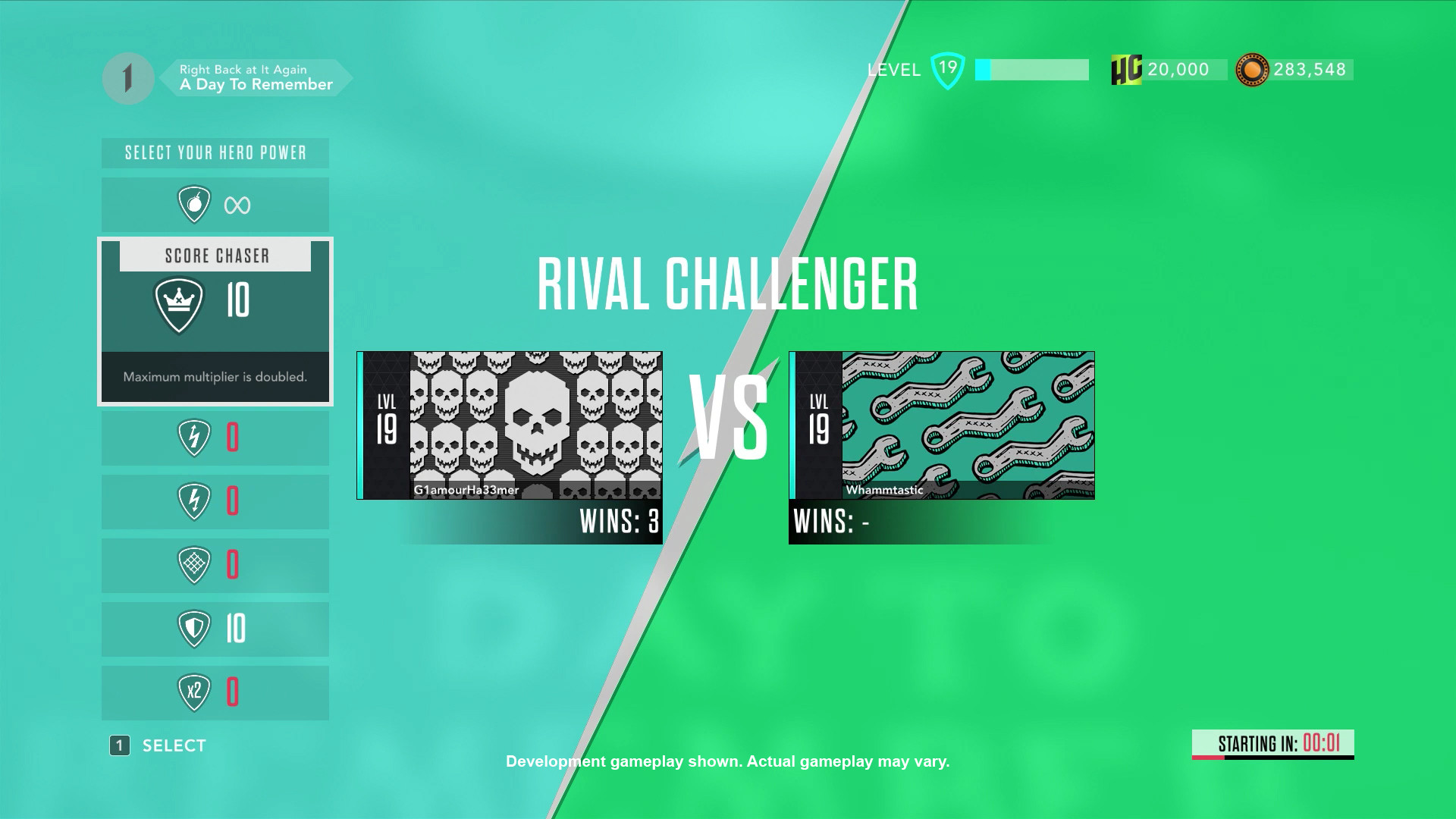 Guitar Hero Live Rivals mode
Guitar Hero Live Rivals mode
Image alt text: A promotional image for Guitar Hero Live’s Rivals mode, showcasing the ongoing updates and new features introduced to the game on PS4.
Both games demonstrate a commitment to ongoing support, encompassing new songs, customization, and gameplay features. Both platforms are poised to improve over time.
Winner – Draw
The Verdict: Guitar Hero Live PS4 or Rock Band 4 PS4?
After this extensive comparison, the ultimate recommendation is nuanced: your ideal choice hinges on your preferred playstyle.
For primarily single-player gamers who anticipate limited local multiplayer sessions, Guitar Hero Live on PS4 is the more compelling choice.
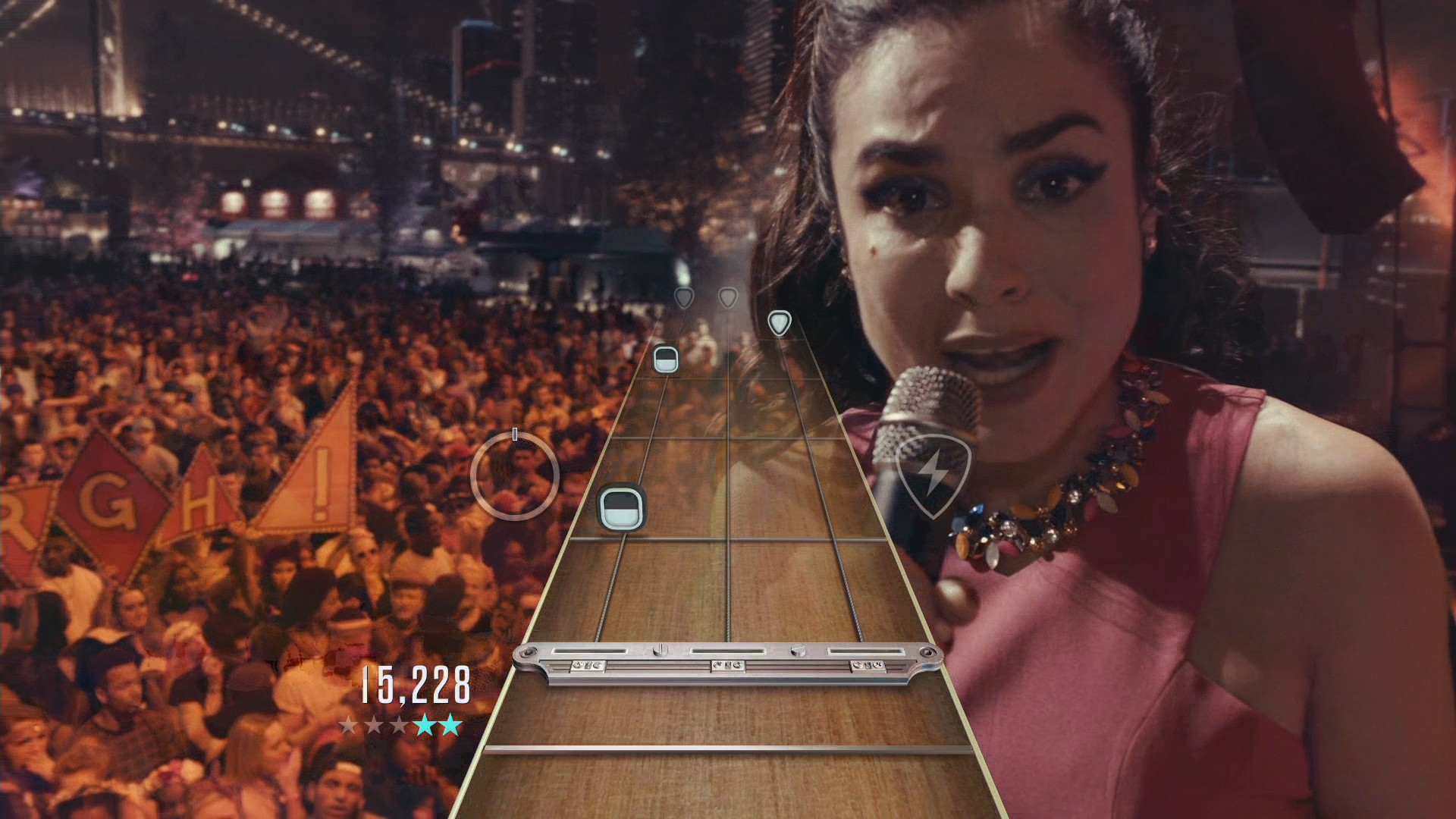 Yes, even despite these beautiful arseholes
Yes, even despite these beautiful arseholes
Image alt text: A humorous image acknowledging the sometimes criticized visuals of Guitar Hero Live, but still recommending it for single-player on PS4.
While the GH Live mode’s live-action visuals are debatable, the GHTV mode and its progression system offer enduring solo engagement.
Its innovative guitar controller provides a fresh and rewarding gameplay experience for rhythm game veterans seeking novelty on PS4.
(As a predominantly solo player, Guitar Hero Live is my personal preference of the two on PS4.)
Conversely, if social gaming and local multiplayer are priorities, Rock Band 4 is the superior option on PS4.
 Rock Band 4 pic 2
Rock Band 4 pic 2
Image alt text: A group of friends enthusiastically playing Rock Band 4 together, highlighting its strength in social and multiplayer experiences on PS4.
Its single-player depth is less pronounced, but its multiplayer excellence and DLC library more than compensate for social gamers. Furthermore, legacy DLC owners can переносите vast libraries to Rock Band 4 within the same console family (e.g., PS3 to PS4).
Price considerations further differentiate the two. Guitar Hero Live with a guitar controller is generally more affordable than Rock Band 4 with instruments. However, Rock Band 4 offers a cheaper software-only option for those with existing compatible instruments.
Ultimately, both Guitar Hero Live and Rock Band 4 offer compelling rhythm game experiences on PS4. Your personal preference for single-player versus multiplayer, visual style, and content access will dictate the better choice for you.
